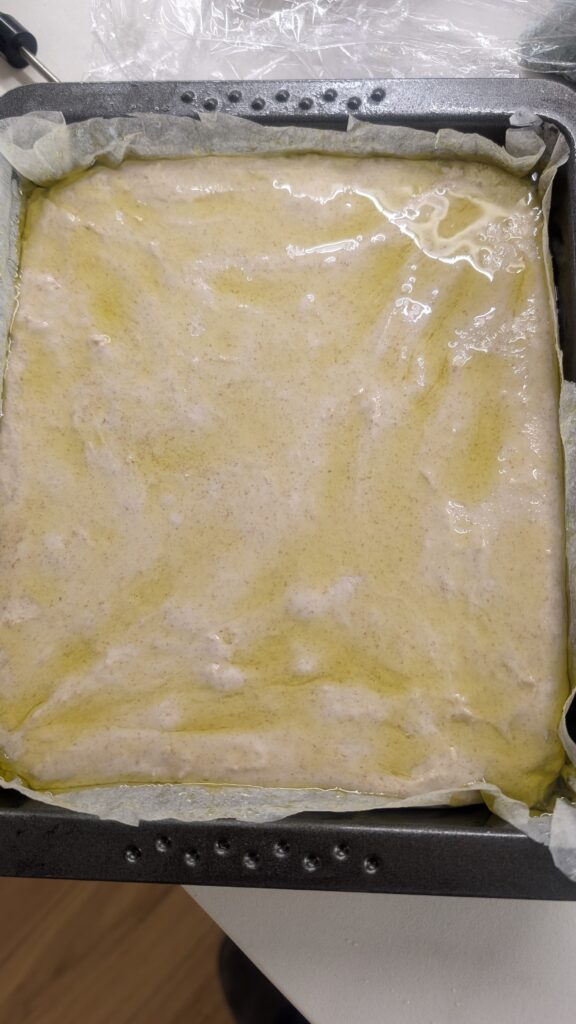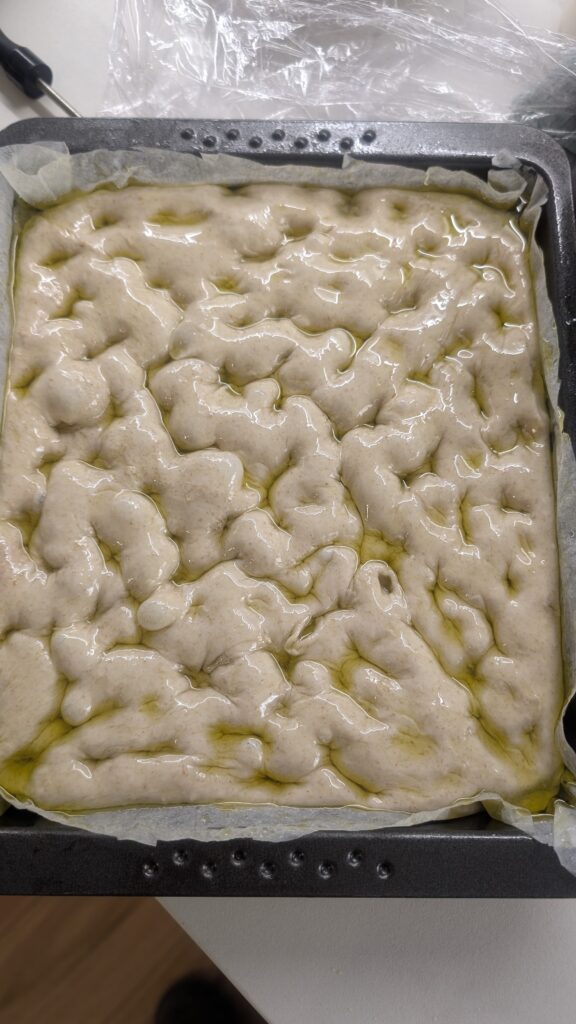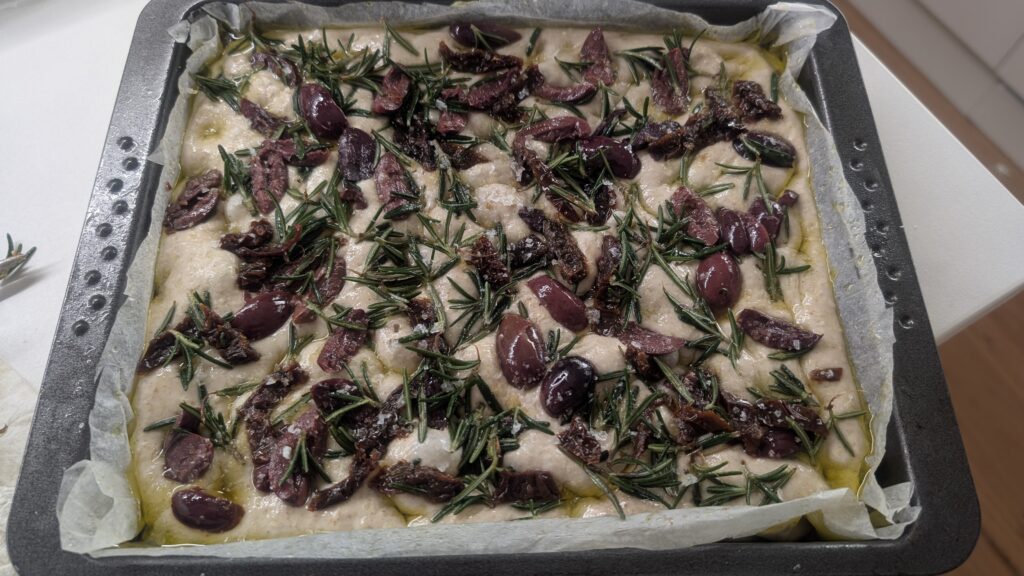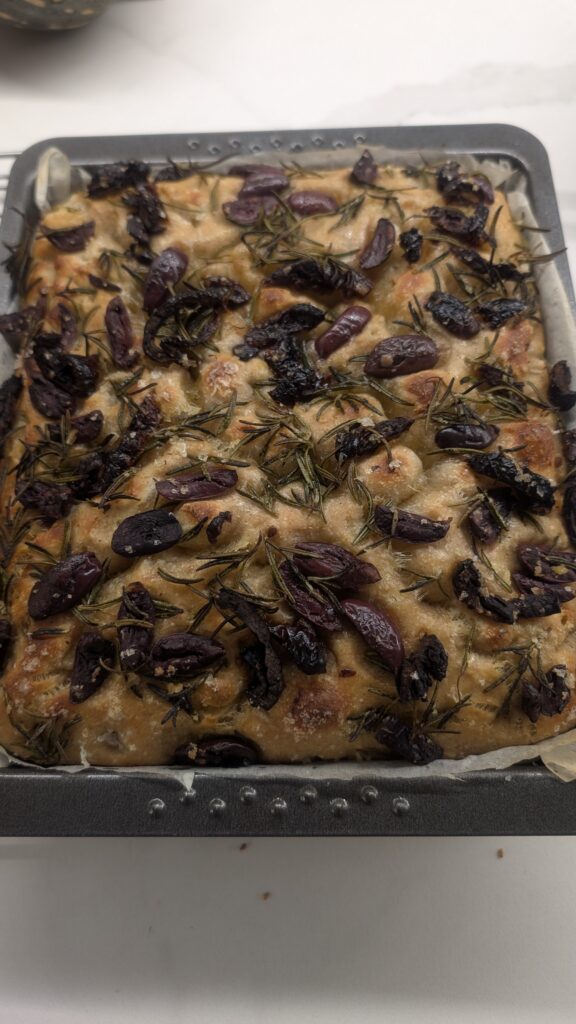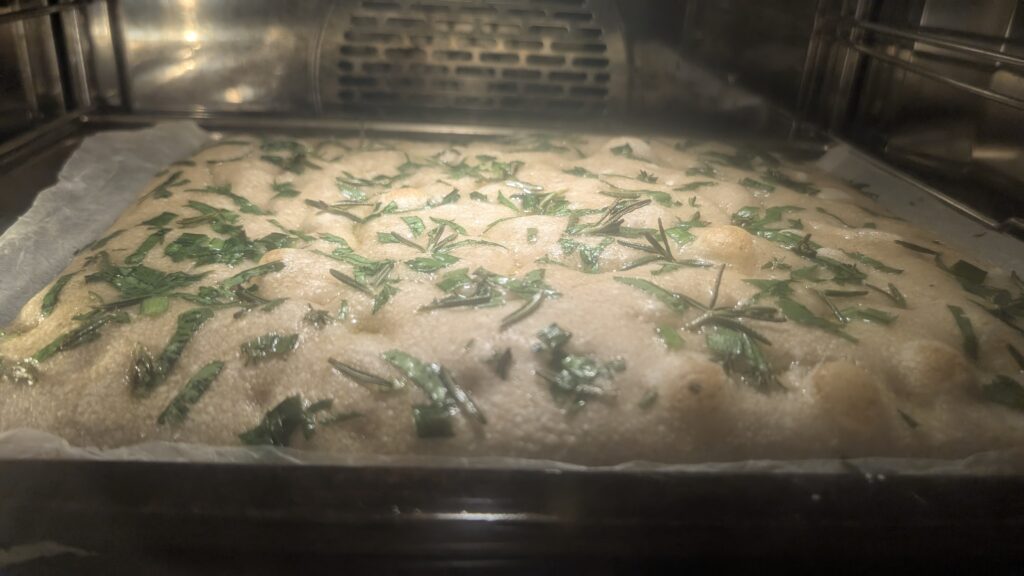

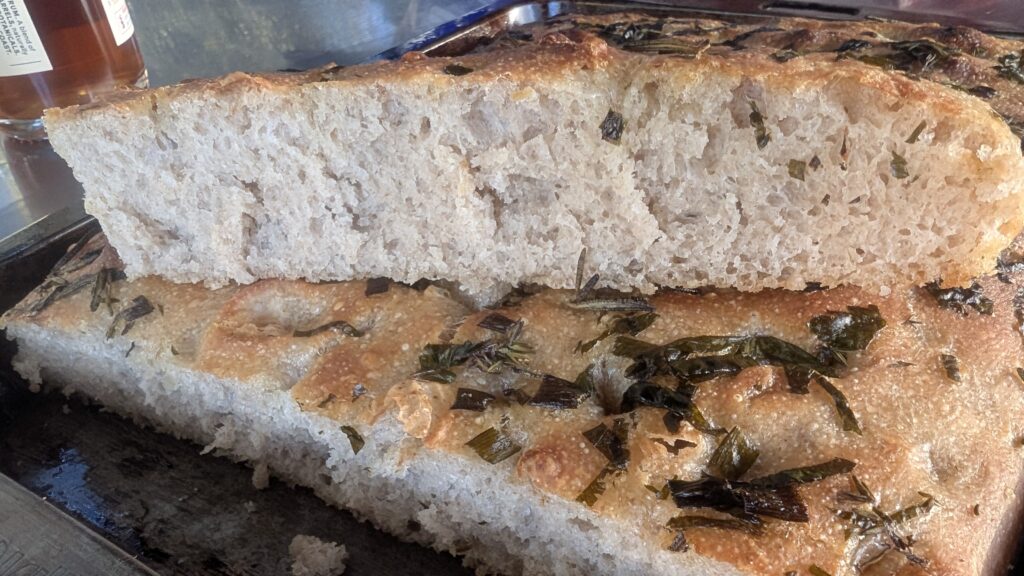 I have been looking for a simple focaccia recipe that uses sourdough, so it makes it pretty healthy. Everything I was finding involved kneading or stretch and folds and lots of intervention. I am in this for the outcome, not the process, so something with minimal effort but a pretty good outcome is my aim. We don’t eat any white bread, or in fact barely any bread at all so this is just for those family or friends for dinner nights where I need something pretty spectacular, yet easy, to put on the table. Once the starter is ready it doesn’t take long to get the dough into the pan. I get the dough into a pan and put it in the fridge to rise slowly if cooking after a four hour rest is inconvenient. When it is time to bake take it out of the fridge and let it come to room temperature and grow a bit more.
I have been looking for a simple focaccia recipe that uses sourdough, so it makes it pretty healthy. Everything I was finding involved kneading or stretch and folds and lots of intervention. I am in this for the outcome, not the process, so something with minimal effort but a pretty good outcome is my aim. We don’t eat any white bread, or in fact barely any bread at all so this is just for those family or friends for dinner nights where I need something pretty spectacular, yet easy, to put on the table. Once the starter is ready it doesn’t take long to get the dough into the pan. I get the dough into a pan and put it in the fridge to rise slowly if cooking after a four hour rest is inconvenient. When it is time to bake take it out of the fridge and let it come to room temperature and grow a bit more.
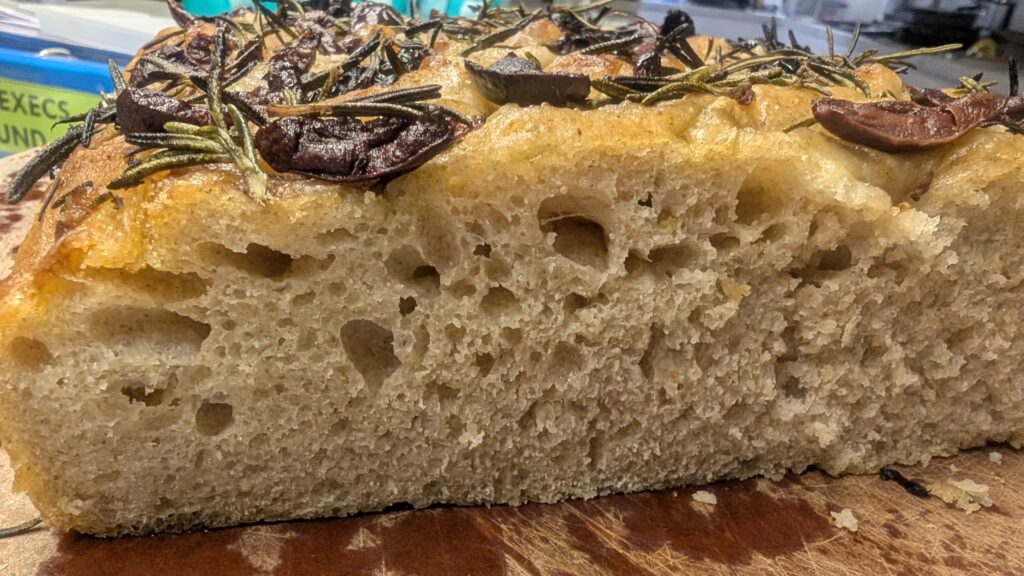
NO FUSS SOURDOUGH FOCACCIA
Take your starter, weigh it and find the difference between its weight and 180g. Divide that number in half and add that weight in rye flour and the same in kefir. Stir it all up well, scrape down the sides, cover with a loose-fitting lid and mark the top of the mix with a rubber band. When it has doubled or even tripled it is time to start this process. If the kitchen is cold I put it in the oven at 27°C (professional baking – proofing setting on my V-Zug combi oven)
Ingredients
- 500g white flour
- 15g Extra Virgin olive oil
- 12g salt
- 380g warm water – aim for 40°C
- 150g starter – you will need to build the starter to this volume in advance.
Method
- Put the mixer bowl on scale and add the white flour and warm water using gram measurements.
- Put the paddle blade in the mixer and mix till the ingredients are incorporated.
- Leave to rest for 30 minutes.
- Now put it back on the scales and add the olive oil, salt and 150g of sour dough starter.
- Use the paddle blade and mix again until incorporated.
- Scrape down the sides, switch to the dough hook, and mix on speed 3 for about 3 minutes until the mix is starting to come away from the sides.
- Scrape down the sides and cover the bowl loosely with a cloth.
- Rest for 30 minutes
- It should have risen a bit so it’s time to knock it down and mix on speed 2 for another 5 minutes or until the dough is somewhat coming away from the bowl and sort of hanging around the dough hook.
- Spray the dish you are going to bake it in with some oil then scrunch up some baking paper and line the pan with it.
- Spread about 2 tbs of EV olive oil on the baking paper.
- Scrape the pretty wet dough out on the baking paper, sort of stretching it out to meet the edges.
- Cover it with plastic wrap and a tea towel and leave in a warm place to rise. This takes about 3 to 4 hours depending on your environment. If that will lead to an inconvenient cook time just put it in the fridge to rise slowly. You will need to take it out to come to room temperature and finish rising about an hour and a half before you want to bake it.
- Perform a poke test – see below.
- Ready to bake: Turn the oven to 240°C with steaming, or use the “flour dusted” setting (or put a separate baking dish or pan in the bottom shelf of the oven to add water to when the dough goes in). Allow the oven to really come to a steady temperature.
- Meanwhile prepare toppings, eg, olives sliced, sun dried tomatoes, roasted tomatoes, oregano, rosemary, sliced roasted capsicum, anything or just bagel seasoning, dukkha, nuts and seeds, za’atar or just salt flakes. Choose whatever flavour will complement the meal. It is a good idea to spray a little oil on any herbs, they cook up nice and crunchy rather than burnt.
- When the dough looks all bubbly and puffy spray (or drizzle) olive oil liberally over the top of the dough then wet your fingers and push them in all over the bread leaving dimples. The oil will puddle into the holes.
- Spread the toppings all over the surface, pushing down lightly. Definitely finish off with salt flakes or 1 tsp of salt dissolved in 1/4 cup of warm water, spread all over the top of the dough before cooking.
- Put the pan into the well preheated oven and cook for 25 minutes.
- Remove from the oven and allow to cool on a rack.
- Serve hot and crispy from the oven or slice and toast.
NOTE:
This can be made as thin or thick as you want. I have used a 22 x 25cm pan and this gives a fairly thick focaccia but for something thinner just use a larger pan.
My preference now is for a 30 x 25cm pan. Well risen this gives focaccia that 3-4 cm thick.
The Poke Test
The poke test for focaccia is a crucial technique used to determine if your dough has proofed sufficiently and is ready to bake. It helps you catch the dough at its peak expansion, ensuring the best possible texture, crumb, and oven spring.
Here’s a detailed description of how to perform it and what the results mean for focaccia:
The Poke Test for Focaccia
Purpose: To assess the amount of gas produced by the yeast/starter and the elasticity (or relaxation) of the gluten structure, indicating if the dough is underproofed, perfectly proofed, or overproofed.
When to Perform It:
You’ll typically perform the poke test after the dough has spent significant time in its final proofing stage, especially if it’s coming out of the fridge or a proofing environment. For your current focaccia, it was key when you removed it from the 26°C oven and when you check it on the counter before baking.
How to Perform It:
* Lightly Flour Your Finger: Dip one of your fingers (usually your index finger) into a small bowl of flour. This prevents your finger from sticking to the sticky, oiled dough.
* Locate a Spot: Choose a spot on the focaccia dough that hasn’t been heavily dimpled or covered with a large herb. A relatively flat, unadorned area is best.
* Gently Press: Gently but firmly press your floured finger into the dough. Aim for an indentation depth of about 1-2 cm (0.5 to 0.75 inches). Do not press too hard or aggressively, as this can deflate the dough.
* Observe the Indentation: Immediately after removing your finger, watch closely how the indentation reacts.
What the Results Mean for Focaccia:
* 1. Underproofed (Needs More Time):
* Appearance: The dough still looks relatively dense, perhaps not as airy or bubbly as expected. The dimples you created might be completely springing back quickly after being made.
* Poke Test Reaction: The indentation springs back immediately and completely, leaving little to no trace of your finger mark. The dough feels quite firm and resistant to the touch.
* Meaning: The yeast/starter hasn’t produced enough gas, and the gluten structure is still too tight. If baked now, the focaccia will be dense, likely have a very tight crumb, and limited oven spring.
* Action: Continue proofing.
* 2. Perfectly Proofed (Ready to Bake!):
* Appearance: The dough looks visibly puffed up, airy, and bubbly, especially on the surface. The dimples may have started to relax or slightly fill in, but they’re still present.
* Poke Test Reaction: The indentation springs back slowly and partially, leaving a slight, shallow dent that slowly reduces but doesn’t disappear completely. The dough feels soft, pillowy, and almost bouncy to the touch, full of air but still with some structural integrity.
* Meaning: This is the ideal stage! The dough has produced a good amount of gas, and the gluten has relaxed enough to allow for maximum expansion in the hot oven (oven spring). It’s still strong enough to hold its structure.
* Action: Preheat your oven to its baking temperature immediately, and bake as soon as it’s ready.
* 3. Overproofed (Act Fast!):
* Appearance: The dough might look extremely puffy, very slack, and perhaps even a bit fragile. Large, irregular bubbles might be very visible on the surface, and some may have popped. The dimples might have completely disappeared, and the dough might even show signs of starting to deflate or spread excessively.
* Poke Test Reaction: The indentation stays completely and does not spring back at all. The dough feels very soft, wet, and fragile, and might even collapse further when poked.
* Meaning: The yeast has consumed most of its food and produced too much gas, and the gluten structure has relaxed too much and lost its elasticity. If baked now, the focaccia will likely collapse, result in a dense, gummy, or crumbly texture, and might have an overly sour or “boozy” flavour.
* Action: While difficult to fully recover, sometimes a very gently deflated over-proofed dough can be salvaged slightly. For focaccia, if it’s very over-proofed, it might be best to cut your losses, or accept a denser crumb. In future, bake sooner or adjust your proofing conditions.
By mastering the poke test, you can ensure your focaccia is baked at precisely the right moment, leading to that coveted airy, chewy interior and perfectly crisp crust.
V-Zug combi oven settings:
Use the “Flour Dusted” setting:
* High Initial Heat for Oven Spring: Focaccia thrives on high heat. Putting it into a preheated oven ensures a rapid expansion (oven spring), creating that characteristic airy, open crumb and bubbly texture.
* Proper Crust Development: The immediate high heat helps to rapidly set the crust, contributing to the desired crispness on the outside while keeping the interior soft. The steam injected by the oven (which the “Flour Dusted” setting uses at the beginning) will further enhance crust development, making it thin and crispy
* Set the temperature to 220-240°C (425-465°F).
* Allow the oven to fully preheat. Your V-ZUG will signal when it’s reached temperature.


